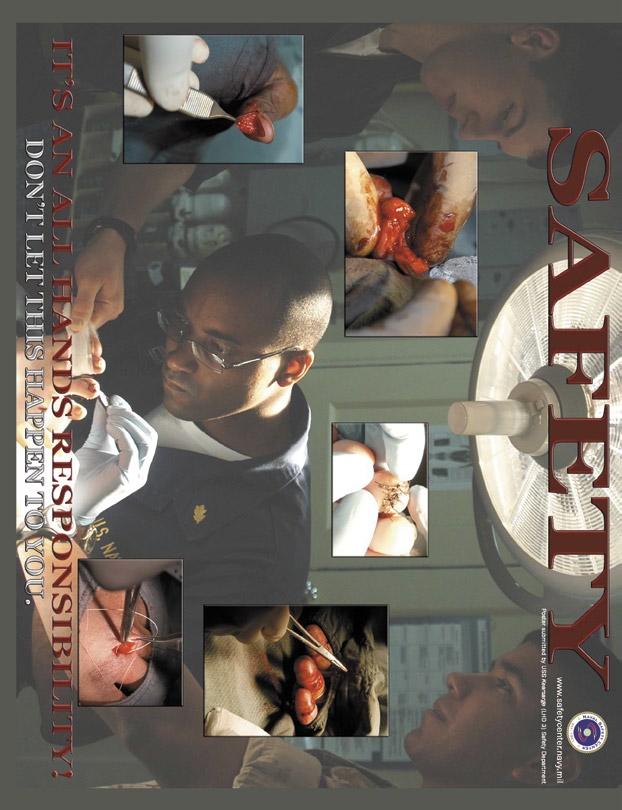
27 minute read
2,000 Man-Hours Later
from MECH Fall 2005
and follow through on your actions to ensure that your evolution progresses as expected.
The evolution had not been progressing as expected, but I put myself in a worse position by assigning myself a duty for which I wasn’t qualified. Had I slowed down and done things correctly, this mishap may not have happened. As it was, this incident forced both my command and me to reevaluate the way we perform aircraft move evolutions. We have since used this incident to show junior Sailors why we have rules and procedures, and how the ORM process can be put into everyday use.
Advertisement
I know that I should not have attempted to act as move director since I was not qualified, nor should I have even attempted the move without a thorough pre-move brief, putting ORM principles to work and analyzing the situation. Had we used ORM, we might have decided that doing an unfamiliar evolution with a qualified but inexperienced crew at night in the cold for a low-priority maintenance task was not worth the risk. We might have accepted the risk but mitigated the hazards by implementing controls such as folding the wings, familiarizing ourselves with the layout of the hush house before putting the aircraft inside, and making sure only qualified personnel were used in each position. We might have started the job with hazard controls in place, then reevaluated the situation and determined that more precautions were needed.
I hope everybody who reads this article learns something from my experience. Although I got to dance on the carpet for the CO, I learned more from this incident than any other in my naval career. On a positive note, we now conduct thorough pre-move briefs and work hard to incorporate ORM practices into everything we do. We have a hush-house checklist and make sure the wings are folded before we move aircraft into the building. We remove the ALQ-126 antenna housing since even a properly positioned jet is less than a foot from the rear wall. We use this incident as a training lesson to prevent future mishaps and we even ORM’d the hush house itself, figuring out that the aft limit lines for the main mounts were missing and needed to be repainted.
In the end, however, everything that I have written about all adds up to one thing: always look before you leap. A careful ORM analysis allows you to do just that.
By AD1 Thomas Miles, VFA-37
Not following tool-control procedures will keep a squadron’s maintenance effort from flowing smoothly. My squadron experienced two incidents of missing tools within weeks of each other.
A workcenter lost a 6-inch extension while doing maintenance in the hangar bay on aircraft 306. Before notifying maintenance control and quality assurance, the technician and CDI did an immediate search. After their unsuccessful attempt to locate the tool, a missing-tool report was generated and a more extensive search of maintenance areas was conducted, including the workcenter and outlying areas of the squadron. All maintenance that had previously been performed was reopened and inspected by the quality-assurance investigator. The search was extended to all aircraft on the line for a period of three shifts, but all attempts to locate the missing tool were unsuccessful.
Convinced that the tool wasn’t in any of our aircraft, they were released safe for flight, and the squadron began training ops in preparation for an upcoming Airwing Fallon detachment. After completing preparations, we packed up and departed for NAS Fallon. After four days of flying, a runway maintainer entered maintenance control after inspecting the runway for debris and turned in a six-inch extension to the maintenance chief. Investigation revealed this tool was the one that had been lost two weeks earlier. The tool was bent and severely nicked, and groove marks ran along its entire length.
Maintenance control initiated conditional inspections for all squadron aircraft. The inspection team discovered damage to the brake-hub assembly and inner rim on aircraft 303’s starboard mainmount. The extension had migrated from the wheelwell and made its way into a small crevice between the rim and brakehub assembly. This tool remained in place for 17 flights until it dislodged itself during takeoff.
The second incident began with a nightshift supervisor’s daily routine of inventorying tools in preparation for the maintenance meeting. Tools were inspected
Photo by Matthew J. Thomas
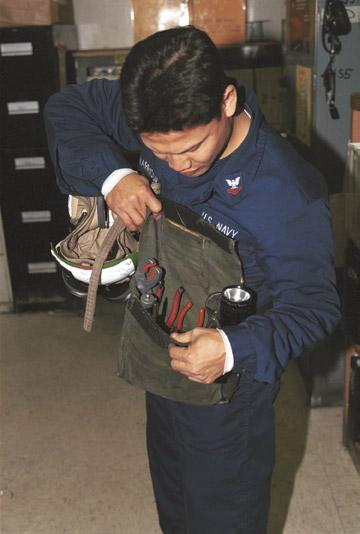
and accounted for, the passdown was reviewed, and the workload was scanned to establish workcenter priorities. Upon completion, the shift supervisor set out for the nightshift maintenance meeting; upon return, he assigned the task of installing aircraft 301’s starboard engine accessories to two workcenter technicians. A technician and CDI checked out a toolbox and departed to accomplish the assigned task. When they were done, they turned in the toolbox and returned to the workcenter. The CDI assigned to the job updated the VIDS-MAF and entered his in-process inspection on the MAF. After a lengthy night of maintenance, the supervisor directed shop personnel to wipe out all tool

boxes and prepare for departure. After the boxes were wiped out and inspected, the night supervisor signed the end-ofshift tool inventory. When the oncoming dayshift held tool inventory, the 3/8-to1/4-inch stepdown was missing. Dayshift workcenter personnel conducted an immediate search but were unsuccessful in finding the missing tool. A report was generated, and the offgoing shift was recalled. The quality-assurance representative traced every step performed by the maintenance crew the previous night. The search extended to all aircraft and squadron spaces. All flight operations were secured, and the search continued for two-and-a-half shifts, totaling more than 2,000 manhours. The tool was located in the tracks of the hangar-bay door. In comparing these two incidents, distinct problems were noted after completing the investigations. The phrase that comes to mind is “before, during and after.” All tools are required to be inspected before, during and after each assigned task. As a fail-safe method of tool control, local standard policy requires quality-assurance representatives to inspect each toolbox before and after completing every task. Simple practices, if adhered to, will prevent the hassle of having to perform searches for missing tools. Although all procedures were followed during the loss of the missing extension, the result could have been catastrophic. In the case of the missing stepdown, several vital things were missed. It was determined the CDI never inventoried the tools before or after completing the task; neither was the box inspected by QA. In addition to those three infractions, the stepdown was missed during the offgoing inspection.
Standard procedures are developed and implemented for a specific purpose: to prevent mishaps. Many lessons have been written in blood. Failure to adhere to policies established in the tool-control program can prove catastrophic.
How does the missing extension mentioned in the first scenario migrate from aircraft 306 to aircraft 303? What can you do to ensure this does not happen in your command? —Ed.
Send BZs to: SAFE-Mech@navy.mil



SSgt. Everett Cooke and Sgt. Daniel Ellison HMH-361
While on deployment in Iraq with HMH-361, SSgt Cooke was serving as crew chief on a routine night logistics mission. The command was moving Marines and equipment from a nearby forward operating base (FOB), and the mission went off without a hitch. After shutdown, he began his daily inspection and found a castle nut had not been installed on the bell crank for the collective flight control. A conditional inspection was done on all flight-control components to check for security and integrity.
During this inspection, Sgt. Ellison noticed that a cotter pin was missing on the servo input for the tail rotor. These two Marines identified and corrected maintenance discrepancies that could have had catastrophic results.


AD3(AW) Thomas Banach VFA-83
While serving as a power plants technician in VFA-83, Petty Officer Banach was tasked with doing an engine turn after another maintainer had finished the pre-inspection and had installed the turn screens. Knowing that he personally had not done the initial inspection, Petty Officer Banach decided to re-inspect the aircraft and found FOD in the No. 1 engine intake just forward of the vortex generator. Had he been less diligent and skipped his own pre-inspection, this FOD would have caused serious damage to the Hornet’s engine.
Petty Officer Banach’s keen attention to detail and by-the-book maintenance saved the Navy $1.3M in repairs, dozens of wasted man-hours, and possibly a life.
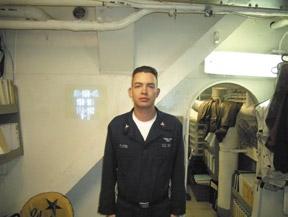
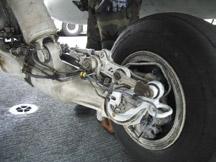
AM2(AW) Steven M. Floyd VFA-192
Dragon 305, an FA-18 Hornet, was being turned around for launch on the next cycle. Petty Officer Floyd discovered the mechanism bolt for the connecting link on the main landing gear planing arm had sheared at the nut section. He immediately notified the flight-deck coordinator, who then contacted maintenance control. A combat FOD walkdown was done, and the sheared section of the bolt, along with the nut and locking tab, was recovered from the landing area. The aircraft immediately was downed. Had this discrepancy gone unnoticed, it could have caused a catastrophic failure of the landing gear.
Cpl. Christopher Pierce and LCpl. David Noble HMM-264
While operating at Al Asad Airbase, Iraq, LCpl. Noble and Cpl. Pierce did a daily and turnaround inspection on a CH-46 scheduled for a functional check flight (FCF). As part of the standard inspection of the control cables, LCpl. Noble found a flat spot on a lateral control cable. Cpl. Pierce confirmed the cable was rubbing against an airframe spar. A more detailed look revealed 5 broken strands of wire that were not visible initially. These strands were broken in a critical fatigue area where even one broken strand downs the plane. The Marines’ alertness, technical expertise, and conscientious efforts toward flight safety prevented a possible inflight failure and the potential loss of the aircraft and crew.




AD2 Santos Rivas HM-15
Petty Officer Rivas found loose ball bearings in an engine-drain screen on a squadron MH-53E helicopter. He quickly notified quality assurance and maintenance control, stating that the ball bearings could have come from the belt tension idler pulley on the nose gearbox. He also said the aircraft needed to be inspected further to find the source of these bearings.
Already turning, the helicopter was shut down for further inspection. While inspecting the suspect area, Petty Officer Rivas and a quality-assurance representative found it was worn, and the race was missing ball bearings.
AE1(AW) Robert Price VAQ-139
During a normal daytime launch, the left generator light on NJ 573 would not go off. Petty Officer Price directed the shutdown of the starboard engine to verify the condition of the port generator. Upon doing this, the aircrew lost all electrical power to the aircraft. As he began to troubleshoot the problem, Petty Officer Price found burn marks on the port engine-bay door and led to the discovery of a shorted, primary-phase wire. Had this discrepancy not been detected, it is highly probable a catastrophic electrical failure and electrical fire would have ensued, jeopardizing the safety of the aircrew and causing severe damage to the aircraft.


AEAN Brandon Averill VAW-121
On the last day of a 10-day detachment aboard USS Dwight D. Eisenhower (CVN-69), AEAN Averill saved the lives of two shipmates.
During the launch of his squadron’s E-2C Hawkeye on cat 3, two sailors inadvertently crossed inside the shot line while working a different launch on cat 2. The Hawkeye on cat 3 had a “thumbs up” for launch and was in tension. Before disaster could strike, airman Averill noticed the fouled deck, immediately suspended the launch, and prevented the loss of two lives at the hands of the E-2’s propeller.
Airman Averill demonstrated the situational awareness of a seasoned professional even though it was only his third time working the flight deck.
AMEAN Joseph Barone VAQ-133
While performing the command sequencing-system leak-test during a 364-day inspection on aircraft 530, AMEAN Barone identified a leak. His thorough inspection revealed the command-sequencer gas-transfer line was disconnected from the ECMO-3’s ejection seat. This discrepancy, if undetected, could have prevented both rear seats from firing in the event of a command ejection. AMEAN Barone’s dedication, initiative, and professional knowledge saved the day and, potentially, aircrew lives.
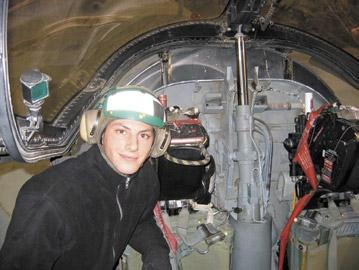
AD2(AW/SW) Douglas Wright HC-6
During a 28-day special inspection, Petty Officer Wright was inspecting the flexible coupling of the engine’s output shaft for cracks. He rotated the No. 1 engine’s output shaft and, with the use of a flashlight, searched for any visible signs of a cracked flex plate. He spotted a protrusion and used a scribe to feel for a lip. For confirmation, he inspected the protrusion with a borescope. Not only did he verify the crack, but he also found another smaller crack on an adjacent flex plate. Petty Officer Wright’s attention to detail prevented a potential aircraft mishap and led to the aircraft’s accurate repair.
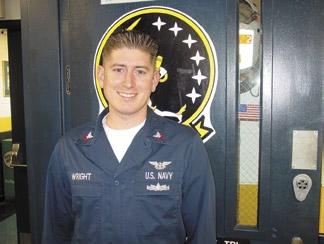
AM2 Chad Mixon HSL-44 Det 1
During a routine 30-hour inspection of Magnum 447, Petty Officer Mixon checked main-rotor dampner bearings for axial play. All bearings passed initial inspection with the bearing-inspection gauge. However, a closer look revealed strands of cloth protruding from between one of the bearings and its race.
Displaying uncommon initiative, he investigated further and found that the liner was separating and causing faulty readings from the bearing-inspection gauge. The gauge couldn’t penetrate the space between the bearing and race. The dampner was removed and replaced.
Petty Officer Mixon’s attention to detail and his willingness to go above and beyond the basic inspection led to finding a problem that could have caused catastrophic failure.


AM2(AW) Jason Brooks VAQ-139
While performing routine postflight maintenance, Petty Officer Brooks discovered damage to the turbine blades of the port engine of a squadron aircraft. The damage was severe, and an additional flight may have resulted in catastrophic engine failure.
His discovery led to engine removal and replacement, thus averting a potential mishap and possibly saving the lives of squadron aircrew and a valuable aircraft.
CROSSFEED
Maintenance Officer Cdr. Al Stephens allen.stephens@navy.mil
Editorial Coordinator ADCS(AW/SW) Gary Dennis gary.dennis@navy.mil
LOX Safety
Time Critical Factors in an Emergency Situation By AMEC(AW) Edgar Cintron
Only a few squadrons conduct follow-on training for LOX/gaseous oxygen safety precautions and hazards. Some commands also aren’t adding liquid or gaseous oxygen as part of the applicable work center’s hazmat Authorized Users List (AUL). Finally, Material Safety Data Sheets (MSDSs) often are not available for training. That’s the gist of my findings during numerous visits.
If you’re a work-center supervisor, you have to give your people job-specific training when they report aboard, with follow-on training thereafter. For your next scheduled hazcom training, conduct a drill, simulating a mishap in which someone gets splashed with LOX. Monitor the Sailors’ responses, especially how they rush through the MSDS binder, looking for the emergency first-aid procedures. All hands must be trained on the dangers and precautions found in the MSDSs before they use hazardous materials.
Another concern is a lack of training in the work centers with regard to emergency pressure-relief tools. Many people involved in LOX evolutions don’t check out these tools and have no idea how to use them. An emergency isn’t the time for everyone to scramble for equipment and read up on how to use it.
The four emergency pressure-relief tools are located in NAVAIR 13-1-6.4, beginning at paragraph 17-28 and including figures 17-6 through 17-8. These tools usually are not included as part of the tool-control program. In most cases, they are not located in the same toolbox marked “Oxygen Use Only,” which presents a time-critical factor in an emergency. Also, some of these tools are not inventoried or accounted for—I find them in cabinets, at the LOX storage area alongside the LOX PPE, in desk drawers, or IMRL boxes. Sometimes, I can’t find them at all.
These tools must be kept in an “Oxygen Use Only” toolbox; if you’re not in compliance, I recommend that you submit a tool-deviation request to add the four items to the toolbox. I also recommend that you have two sets—one in case you have a detachment. Most squadrons have enough LOX PPE to support home-guard, but few have enough emergency pressure-relief tools to support both. Most commands we visit also use LOX without established procedures for those converters with a dime-like protrusion (indicating a critical over-pressurization), as found in Ref. (b), page 4-8 “warning.”
Here are some other helpful hints: • The pressure-gauge/relief-valve test fixture has an oxygen gauge that requires a green “Cleaned for Oxygen Service” label and is required to be on a six-month calibration cycle. • Make sure you have an MSDS available for the type of oxygen used on your aircraft, and make sure it’s listed on your AUL. • Remember, LOX can produce a powerful explosion if not handled correctly. Is there enough room around your LOX servicing/stowage area to allow for such an explosion without any personnel being injured or aircraft being damaged?
Be proactive in training. Don’t get complacent or lose situational awareness while handling LOX converters or holding servicing evolutions. Keep your shop, squadron, ship and flight deck a safe place to work.
AMEC(AW) Cintron is a maintenance analyst at the Naval Safety Center.
QA Program
How Strong Is Your Auditing Process? By AMC(AW) Paul Hofstad
When I do a survey, I look for consistency in the such as CDQARs in the PR shop, but, when a comaudit process. I ask other team members what mand has to put a CDQAR in the line division, then they are finding in their particular programs. manning needs to be addressed. I then look at the most recent audits to see if they Another area of concern is the lack of recent match what other surveyors are finding. When they audits on QA itself. It’s necessary you make sure don’t match, there’s a problem—and that’s what your own backyard is squared away before you I found during a recent overseas visit. More times pass judgment on other programs throughout the than not, the auditing process performed by qualitycommand. In many cases, the most recent audit is assurance work centers in various commands and more than two years old. Sometimes, the QA work communities had holes. centers audit themselves, which creates a problem
To be more precise, if the QA audit merely with objectivity. We sometimes tend to overlook such states, “No discrepancies; this program is running things because we don’t want to air out our dirty smoothly...” and other team members are finding laundry, but, in the long run, whom are we hurting? problems, I know one of two things is happening. Remember, QA is the check and balance within The command isn’t allotting enough time for the a command. If audits are performed poorly, or audit, or personnel aren’t looking hard enough. manning isn’t sufficient, then the command suffers,
Some QA work centers I recently surveyed and another link in the chain is broken. You have to were grossly undermanned. With a command ask yourself, “Am I willing to take the chance on the operating on two shifts, manning a vigorous flight safety of my aircrew and my maintenance personschedule, and still performing audits, the number of nel?” Fuel surveillance, hydraulic contamination, assigned QA personnel may not be enough to do and oil analysis are just a few of the programs that what’s required. CNAF 4790.2, Volume 1, Chapter can cause havoc within your command. 14, states that QAs will be represented by all rates. AMC(AW) Hofstad is a maintenance analyst at the Obviously, there will be caveats to this requirement, Naval Safety Center. Maintenance Training
Maintaining an ORM-Based Training Program By ADC(AW/SW) Gary Eldridge
Attention to detail is especially crucial when tors. These instructors bear the burden of training maintainers are working flight-line or flight-deck “by the book” and leaving out bad habits they may operations. Moving aircraft can be just a mishap have acquired over time. Proper training requires away, which is why all hands involved in such these instructors to research, plan, test, and evaluoperations should be enrolled in a stringent training ate before disseminating information. Remember, program. without proper training, we cannot determine
Studies show that more than 60 percent of technormal from abnormal operation. Without proper nician training is performed on the job. This statistic, training, we cannot determine if we’ll be at risk. however, says nothing about the quality of the trainBefore committing personnel to OJT through a ing. While OJT can be an invaluable tool, it also can command-generated maintenance-personnel-minibe a risky and costly method of training. mums checklist, ask yourself these questions:
Usually, qualified senior technicians who have • Have I researched the MIMs/instruction/IRACs proven themselves provide the training as instructo ensure compliance?
• Do I have the knowledge to perform the task? • Do I have the technical data to perform the task? • Have I previously performed the task? • Do I have the proper tools and equipment to perform the task? • Have I had the proper training to support the task? • Am I mentally prepared to perform the task? • Am I physically prepared to perform the task? • Have I taken the proper precautions to perform the task?
• Do I have the resources available to perform the task?
Practice what you preach, and preach what you practice in all training scenarios. Cutting corners starts somewhere and ends when a shipmate is hurt or killed. Unfortunately, that’s when we realize we have a training deficiency. The first component of ORM is to recognize hazards—it starts with us.
ADC(AW/SW) Eldridge is a maintenance analyst assigned to the Naval Safety Center.
Tool Control
I Didn’t Know That By AMCS(AW) Mark Davis
CNAF 4790.2 clearly defines how multi-piece tools are supposed to be managed. That reference states, “All tools that are multiple-piece shall be identified in detail, for example, ‘stamping dye set 10 pieces plus 2-piece case total 12,’ or ‘feeler/ depth gauge 14 blades,’ or ‘hacksaw with blade.’”
You might say that most tools have multiple pieces, and, although you might be right, common sense must apply when we look at each tool. The general rule of thumb is that if a tool has parts that are removable by hand, then it must be accounted for as a multi-piece tool—it’s that simple.
In an airframes work center, the most common problem we find usually concerns a tool in the metal working box. The culprit normally is a 12-inch combination square. I find this tool often accounted for as only a one- or two-piece tool. In reality, however, the combination square has six pieces, including the main body, the slide ruler, the guide pin, the adjustment knob, the spring, and the scribe (see accompanying photo).
If you’re a work-center supervisor who has multi-piece tools with missing parts, it should concern you as much as it does me to find those discrepancies during my visits. Most times, though, supervisors display little if any concern. Here’s the correct response, as outlined in CNAF 4790.2: “A missing/broken/worn-tool report is promptly initiated by the individual reporting or finding the missing tool.” The reference goes on to say this report must be forwarded to maintenance control or production control.
Another matter that concerns me is who in the various work centers conducts beginning-of-shift and end-of-shift tool inventories. Does anyone? Is
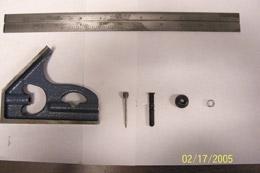
it the CDI or tool-control petty officer? According to CNAF 4790.2, it’s the responsibility of the workcenter supervisor to conduct both beginning and end-of-shift tool inventories. The reference says, “The work-center supervisor shall inventory all tool containers, special tools, and PPE at the beginning and end of each shift and document change-of-shift inventories, using a logbook, such as a pass-down log. Ensure tool containers are FOD-free at all times.”
Once again, though, we need to apply a little common sense. The day-shift supervisor should conduct beginning and end-of-shift inventories for days, while the night-shift supervisor should handle both inventories at night. We also understand there will be times when a supervisor may be on liberty or at a medical appointment. In those cases, a CDI may conduct the inventories. Just make sure those occasions are the exception, not the rule.
As aviation professionals, we have numerous references with which to conduct maintenance. Our “bible,” though is CNAF 4790.2. How long has it been since you really sat down and read over your area of responsibility? Don’t be the one who answers with, “I didn’t know that” the next time we cite a passage from one of those references.
AMCS(AW) Davis is an airframes analyst assigned to the Naval Safety Center.
Respiratory Protection
It’s a Matter of Life and Breath By AMCS(AW) Mark Davis
Every Navy command that uses respirators must training, and AM1(AW) have a respiratory-protection program manager Veiser of VQ-1, NAS (RPPM) and/or assistant who is required to be Whidbey Island, is right a graduate of the NAVOSHENVTRACEN Respirator on the mark in all three Protection Program Management course (A-493- areas. I have to extend 0072). The first responsibility of this person(s) is to a hearty Bravo Zulu to complete an industrial-hygiene survey, which will him for maintaining an indicate all the hazards within work centers. The exemplary respirator command’s safety office should have a copy of this program. He provides survey, and it’s also recommended that a copy be readers with an outstandposted in each work center. ing example of what a
I look for several things when reviewing a comrespirator locker should mand’s respirator-protection program, starting with look like—very neat and the SOP. I want to know if it’s command-specific. well organized—as you’ll Most wing or base SOPs are too general and don’t see in the accompanying satisfy naval requirements. Another item I look at photo. is the record of usage, cleaning, storage, and filter For complete details change-out. I want to make sure the RPPM mainabout how you, too, can tains such a record and that it’s up to date. maintain a squared-away RPPM program, use these
When it comes to the medical-screening forms, references: the correct one is found in OPNAVINST 5100.23F, • OPNAVINST 5100.23f, Chapter 15 Chapter 15, Appendix A. I see a lot of local forms • OPNAVINST 5100.19D, Chapter B6 that don’t have all the required information. Using • NA-01-lA-509, Appendix B the form from OPNAVINST 5100.23F, though, will • Code of Federal Regulations, 29 CFR ensure candidates for the RPPM program are fully 1910.134 qualified. AMCS(AW) Davis is an airframes analyst assigned to
My concern is with organization, accountability and the Naval Safety Center.
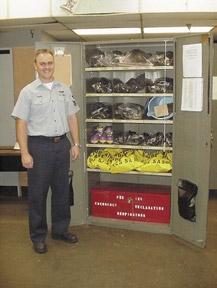
SE Maintenance
Dotting the I’s and Crossing the T’s
By ASCS(AW) Phil LeCroy
How would you feel about using a piece of support equipment that had been non-RFI for the last nine years? If you’re like me, not real receptive, but this very situation occurred on a recent survey. As a matter of fact it, happens more than most people realize.
A nitrogen walk-around bottle is used almost every day. We found one where the hydrostatic test was last done in 1991. That test is supposed to be done on high-pressure gas bottles every 5 years. Meaning the bottle was almost ten years overdue. Hello!
Upon further review, the /51 Card did not even list a hydrostatic test date. To make matters worse, the acceptance inspection was signed off and showed that the hydrostatic test date had been verified. The unit did not have a calibration sticker, and pre-operational inspections were not being done.
When we asked the supervisor for the /52 Card, it couldn‘t be found. Who was concerned about the
safety of others? Where was QA? Was anyone making sure that aircraft were being serviced properly?
The unit was taken out of service, but how many hands did it slip through in the last nine years? Many technicians, supervisors, QAR’s, and analysts could have and should have caught the error.
The survey team also found a nitrogen cart at a different command with an expired calibration sticker. The unit was three days overdue for calibration. Not a long time, but what might happen if the gage was off, personnel were servicing an aircraft tire, and it blew up? What if someone had been hurt during those three days? The shop had signed the /52 Card stating a good and thorough inspection had been done. Step 10 of the pre-operational inspection clearly directs personnel to ensure that the calibration is current.
In another command, another walk-around bottle was missing a calibration sticker. A squadron representative was asked to do a pre-operational inspection on this unit. He had a checklist in hand but skipped step 3, which directs personnel to check for a current calibration. If it’s missing that automatically makes the unit non-RFI because the calibration is not current.
Follow basic procedures and remember the instructions and checklists are in place to keep Sailors and Marines safe. It’s time to start dotting the I’s and crossing the T’s.
ASCS(AW) Lecroy is a maintenance analyst assigned to the Naval Safety Center.
Class C Mishap Summary By ADCS (AW/SW) Gary Dennis
From March 01, 2005 to June 30, 2005, the Navy and attempted to hold onto the weapon, but as the tension of Marine Corps had 43 class C’s that involved 46 aircraft. his gunner’s belt increased, he was forced to release the
The damage total was $2,664,439. weapon. The barrel, receiver, ammo can, and mount landed • A Marine ordnanceman fell from an aircraft while on the desert floor. The vibration from firing the weapon, doing a safe for flight inspection on an FA-18D at night. The along with the weapon being pointed out the left side of the
Marine failed to ensure a proper foothold before transferring aircraft, placed force in the direction of the slotted openhis weight to his right foot, which barely had made contact ing in the floor interface plate. That arrangement allowed with the ladder. Sensing a fall, he pushed away from the the quick-release assembly to slide out of the floor plate, aircraft to avoid hitting his head or face on the leading-edge and the weight and center of gravity of the weapon forced extension or the ladder. Landing on his out-stretched left it out the back of the aircraft. An investigation revealed the hand, the Marine’s body weight drove his left arm into the RMWS was installed improperly and the tail gunner failed to concrete, fracturing his left elbow and wrist. inspect it properly, resulting in $38,000 damage. • A ramp-mounted weapons system (RMWS) was • After their C-2 landed, the aircrew found the forward damaged when it departed an in-flight CH-53E. During a propeller-servicing door on port engine had struck the day aerial-gunnery shoot, the aircraft was flying at 500 feet base of the four propeller blades. Investigators found that a and 90 knots. The tail gunner was firing the weapon out technician did a CDI inspection of his own work. This lack the left side of the ramp when the RMWS’s quick-release of supervision led to a $171,468 mishap. assembly slid out of the floor interface plate. The tail gunner ADCS (AW/SW) Dennis is a maintenance analyst at the Naval Safety Center.

During the National Safety Council conference in Orlando, Fla., Mech became aware that the company Simple Green has developed an aircraft cleaner. Several aircraft manufacturers, including Boeing, have accepted the new formula. However, a MILSPEC has not been issued for this product. Until the product is approved, Extreme Simple Green Aircraft & Precision Cleaner is NOT authorized for use on naval aircraft.
